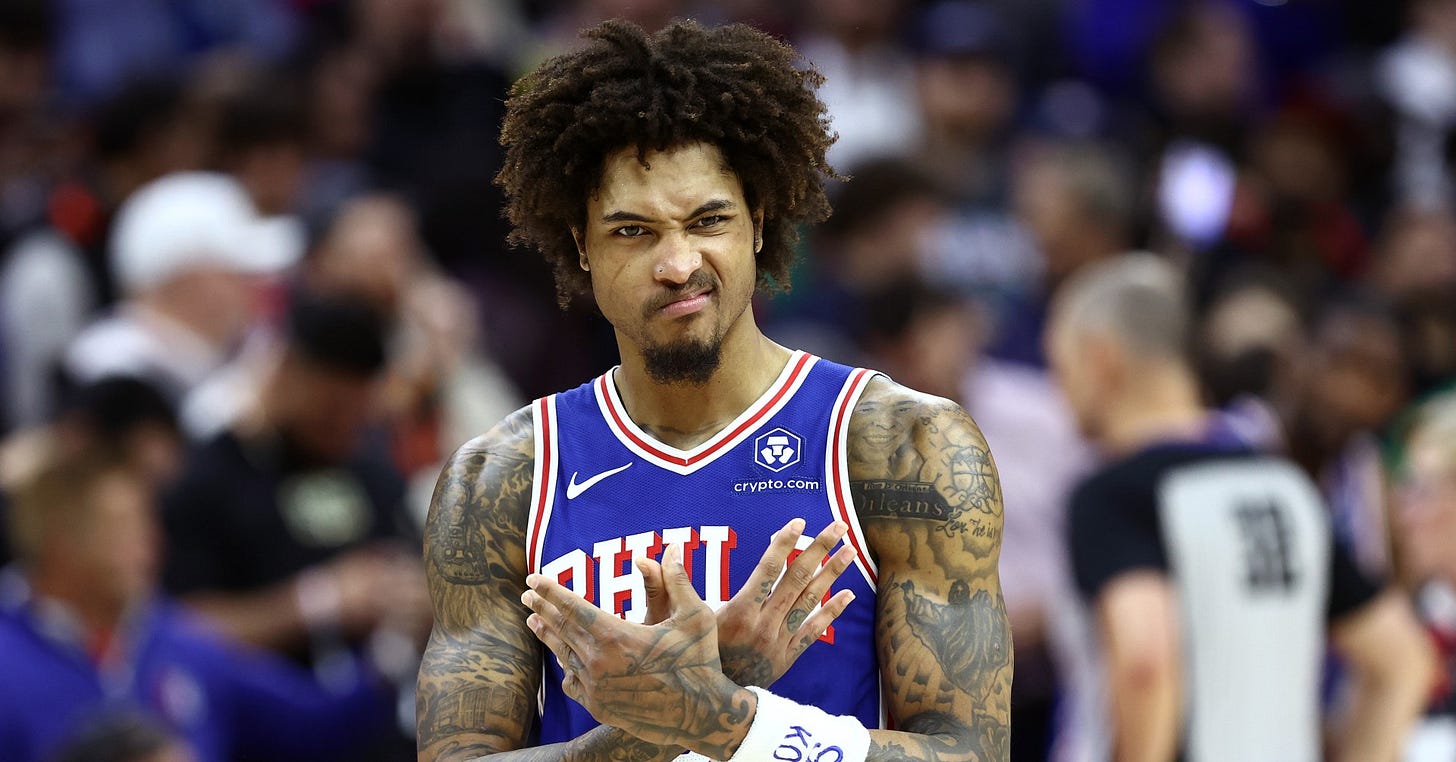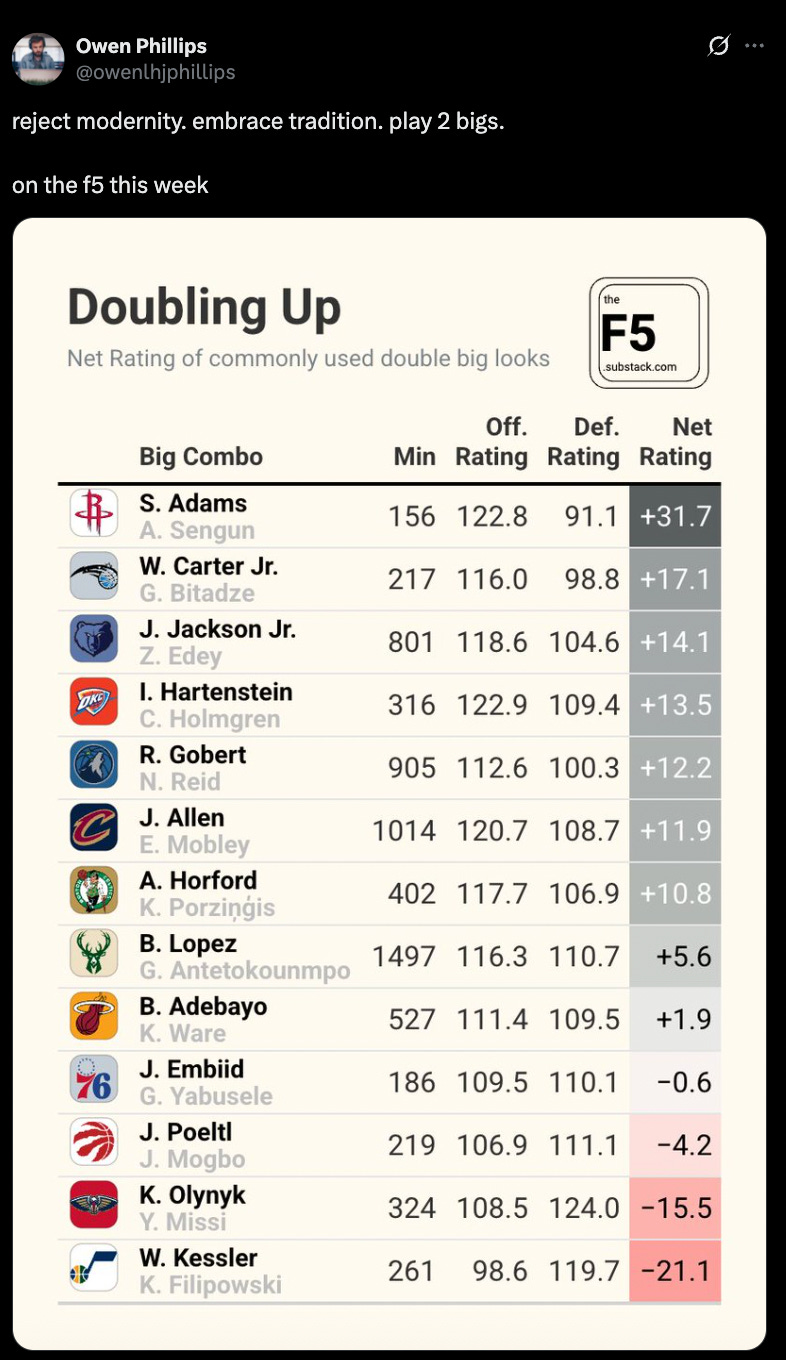Coming out of last off-season, a large part of why everyone was so excited about this Sixers team was the fact that the projected starting five seemed to fit together so well. People were generally excited about the idea of Kelly Oubre Jr. and Caleb Martin rounding out a starting five around Tyrese Maxey, Paul George, and Joel Embiid, and the extent to which size or positional fit was considered a major concern was not all that significant.
And while we didn’t get to see that five-man unit for extended stretches, it did end up being the Sixers’ fourth-most played lineup on the season, per Cleaning The Glass, and it was a massive disappointment – it had a disastrous net rating of -10.6 points per 100 possessions.
While a lot of the things that led to the Sixers’ downfall this season were out of their control, the one thing that we likely should have foreseen as a real problem is the fact that their roster was just devastatingly small. That starting lineup could never have gotten through the rigors of the regular season with so little size to complement their three stars. The front office talking themselves into Caleb Martin being a “power forward” was one of the biggest miscalculations of the off-season, and signing old guards like Reggie Jackson and Kyle Lowry as opposed to seeking out more size and length on the wing proved to be a monster error.
Digging through the lineup data further shows what an egregiously small rotation the Sixers were forced into playing last season. Their second-most-used five man lineup of the entire season was Maxey, Eric Gordon, Justin Edwards, Kelly Oubre, and Guerschon Yabusele – a tiny, ill-fitting lineup that posted a terrible net rating of -14.4. Per Cleaning The Glass, the Sixers played a ridiculous 2191 possessions with Kelly Oubre as their power forward this year; that’s more than a quarter of the entire season (!), and more than twice as many possessions that Yabusele (the team’s most natural power forward) played at that position. Ultimately, the Sixers’ small-ball lineups yielded no upside – they were one of the league’s worst at-rim defenses, and they were the worst defensive rebounding team in the league, while also being terrible in both transition and half court offense.
It’s possible that the Sixers could have gotten away with these types of lineups 10 years ago, when small-ball was still a relatively new thing and you could obliterate teams with plodding bigs by putting enough shooting on the floor. But in today’s day and age, these four-guard lineups with a 6-foot-8 center are just completely untenable: If anything, the league is trending more towards traditionally-sized front courts. As big men have become more skilled, bigger lineups have become more and more valuable. Many teams are playing two-big lineups with major success.
This, along with the fact that the Sixers may end up trying to build their future around two relatively small guards in Maxey and McCain, makes me believe they need to make it a priority to go into next season with a surplus of size on the wing and in the front court.
Obviously, winning the lottery and getting Cooper Flagg would accomplish a large chunk of that, but if the Sixers’ pick lands 2-6, I’d be very tempted to trade back to a place where they can draft a frontcourt player like Derik Queen, Asa Newell, or Collin Murray-Boyles. For now, it’s not worth spending a ton of time on that discussion – we’ll obviously have more certainty on what the game plan should be there in a few weeks once the lottery happens.
Even if the Sixers do land a frontcourt player in the draft, though, more work needs to be done on that front. I’d look at ways to bring in players who can split time between the four and the five, like Santi Aldama, Kelly Olynyk, Larry Nance, or perhaps Dean Wade. If Oubre, Drummond, and/or Eric Gordon opt into their player options, I’d happily package them along with some second-round picks for a player in the mold I’m describing. Bringing back Yabusele at the right price and allowing him to spend more of his time at the four next year would also be very helpful – lineups with Yabusele fared well by Sixers’ standards, especially when he played next to Embiid.
I could even be talked into using the non-taxpayer mid-level (which can go up to $14 million, and would really only be possible if they lose their draft pick to OKC) to bring in a true center who shoots threes, and hope that they could play just enough next to Embiid when he’s healthy in order to make the signing worth it. Brook Lopez fits the mold here – I’d happily give him three years, $30 million from the NTPMLE to have him start 50 games at center and be a back up five / part time four in the games that Embiid plays. A Lopez-Embiid front court may wind up being too plodding to play any serious minutes in high leverage situations, but if you accept that Embiid is likely to miss around 50 games per year from here on out, it’s certainly worth investing $10 million in someone like Lopez, and any minutes that they’re able to play together is merely gravy.
Acquiring more length on the wing gets a little bit more tricky. I’ve written at length on the idea of trading for Herb Jones; I absolutely love him as a player, but it’s a bit of a questionable move to give up quality draft picks for a non-star at a time when the team could potentially be teetering on a rebuild. Still, if the team’s goal is to be remotely competitive next year, Paul George absolutely cannot be the only 6-foot-8-ish rangy wing who can make plays on defense – I like Justin Edwards, but even he does not have quite the skill set I’m talking about here. He’s a hair over 6-foot-6, he’s a relative non-presence on the glass, and he doesn’t generate many deflections. You’ll need multiple players who do those things in order to address these problems. With the surplus of frontcourt bodies in Dallas, P.J. Washington might be someone worth inquiring about – it’s never a bad idea to give Nico Harrison a call.
Aside from just the talent deficit caused by injuries, one could make a decent case that a lot of the Sixers’ struggles this season had to do with missing open threes, being out of sync due to constant lineup changes, and simply lacking a consistent degree of effort and focus. You know what would make all of those things a lot less damaging? If they were just bigger, stronger and more athletic than their opponents on a nightly basis. A nice, easy remedy to not being crisp in terms of shooting and overall execution on any given night is to have the option to out-muscle your opponents and win the possession battle.
Instead, the Sixers were catastrophically small last year, and it multiplied the impact of all of those issues exponentially. This off-season, they need to correct that. Assuming they bring back Quentin Grimes, they will have more than enough backcourt talent on the roster with their top-line guard trio. All other resources should go towards making sure this team isn’t just three centers, Paul George and 11 guards.
Mike O’Connor is the best O’Connor in basketball writing. Previously of The Athletic, you can find Mike on Twitter @MOConnor_NBA. Mike’s writing is brought to you by Body Bio, supplements based on science, focusing on your gut and brain health.






